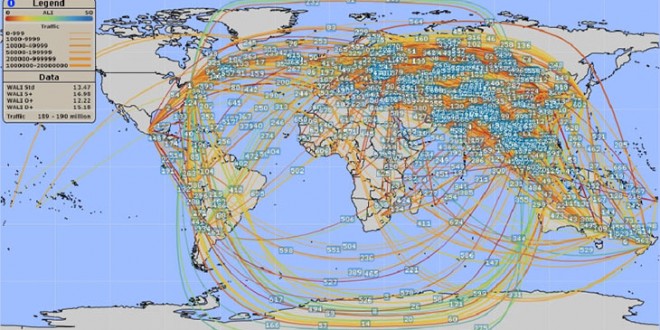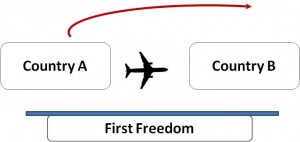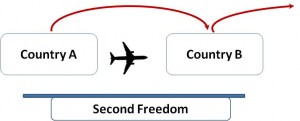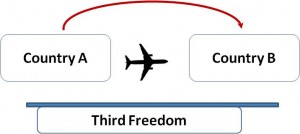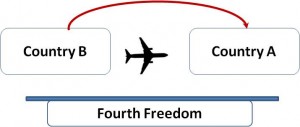This article is the last of the two part series on Air Services Agreements. In part 1, we highlighted aspects of bilateral air services agreements. This part highlights freedoms of the air which are equally important and are included in bilateral provisions.
What are “Freedoms of the Air”
Freedoms of the air or traffic rights are aviation agreements between two countries which grant a country’s airline(s) approval to enter and land in another country’s airspace. These were formulated in 1944, after World War II when 54 nations came together, in Chicago to discuss civil aviation, and agreed on a series of rules in the Convention on International Civil Aviation (commonly known as the Chicago convention). There are generally 9 freedoms of the air that define the framework under which air services operate across the globe. These are:
First Freedom – the right granted by one State to another State or States to fly across its territory without landing. Also known as overflight rights. This has recently come to the forefront with geopolitical tensions and Russia threatening to suspend overflight or first freedom rights for US and EU carriers as a response to sanctions.
Second Freedom – the right granted by one State to another State or States to land in its territory for non-traffic purposes. Also known as a technical/ refuelling stop.
Third Freedom – the right granted by one State to another State to fly in traffic (revenue passengers) coming from the home State of the carrier.
Fourth Freedom – the right granted by one State to another State to take on, in the territory of the first State, traffic (revenue passengers) destined for the home State of the carrier.
The third and fourth rights are always granted together to ensure network balance.
Fifth Freedom – the right granted by one State to another State to put down and to take on, traffic coming from or destined to a third State. Also known as beyond rights. Fifth freedom rights are coveted as they give an airline the ability pick up passengers and carry them to a third destination which can help feed route segments. Integrating fifth freedom rights into overall airline network strategy is fairly complex but when leveraged effectively with a well thought out strategy, these rights can help develop new markets, promote the airline brand and deliver overall profitability. For instance, Singapore airlines has used fifth freedom rights quite effectively over the years and these are strategic to its network. Some fifth freedom routes Singapore has flown are: Los Angeles-Tokyo; Houston-Moscow; New York – Frankfurt; San Francisco-Hong Kong; San Francisco-Seoul. In fact, routes such as Los-Angeles Tokyo became so popular that the airline is able to command a premium on them (currently SQ uses a A380 for that route). Compare this to Air India which has fifth freedom rights and in the past used to fly Frankfurt – Chicago and London – Chicago and London – New York sectorsbut has not quite been able to leverage them in a similar manner.
ICAO characterizes all “freedoms” beyond the Fifth as “so-called” because only the first five “freedoms” have been officially recognized as such by international treaty. These are also controversial rights especially as some of them involve the ability for a foreign carrier to fly domestic routes — termed as “cabotage.”
Sixth Freedom – the right of transporting, via the home State of the carrier, traffic moving between two other States. Though not incorporated into any agreement this is a critical right. Carriers such as the ones in Middle East rely on this right for the success of their business models.
Seventh Freedom – the right granted by one State to another State, of transporting traffic between two foreign states any with no requirement to necessarily operate to any point in the territory of the recipient State, i.e the service need not connect to or be an extension of any service to/from the home State of the carrier.
Eighth Freedom – the right of transporting cabotage traffic between two points in the territory of the granting State on a service which originates or terminates in the home country of the foreign carrier. That is a foreign airline flies from its home country (Country A) to Country B and then operates domestic services in Country B.
Ninth Freedom – the right of transporting cabotage traffic of the granting State on a service performed entirely within the territory of the granting State. That is a foreign carrier operates domestic services.
The eighth and ninth freedoms are especially controversial because they allow foreign carriers to fly on domestic routes (referred to as cabotage). The U.S. which is the worlds largest air travel market fiercely protects its own aviation market by not granting these while several airlines consantly try to exert pressure to the U.S. to open access to its aviation market by granting these rights. These rights are granted in cases where a country may not have developed its own aviation talent, infrastructure and ecosystem and consequently has limited ability to support safe and reliable air services. Eighth and ninth freedoms are also vehemently opposed by labor unions as they claim it leads to outsourcing and loss of jobs.
Traffic rights as aviation assets
Freedoms of the air or traffic rights are aviation assets for a country. Airlines are particularly keen on getting unrestricted traffic rights to access emerging economies such as India, China and Brazil where the demographics coupled with rising income travels are fueling the demand for air travel. India last year had more than 20 carriers operating using sixth freedom rights which carried passenger to more than 150 countries worldwide.
While India’s treaties with several nations allow for fifth and sixth freedom rights, due to the challenging financial position Indian airlines find themselves in, these rights are not being used to their full potential. Nations with stronger airlines have used these rights to their advantage.
For instance, India, with around 26 million total international passengers in 2013 (one way) and growing, is an extremely lucrative market. Approximately 40% of the international traffic from India is headed westbound. Out of this ~6million passengers are transported by airlines using sixth freedom rights. Within this segment,i.e. passengers being transported by carriers utilizing sixth freedom rights, the largest destinations in terms of passenger volumes were USA, Saudi Arabia (both Haj and labour traffic) and the United Kingdom. Together these destinations accounted for ~45% of the traffic.
The dominant airlines were Emirates, Lufthansa, Singapore Airlines, British Airways and Qatar Airways which accounted for ~60% of total sixth freedom traffic. As is clearly evident, all of these airlines have sizeable geo-strategic hubs, robust networks and a focused effort on capturing traffic out of India.
Outlook
With ideal demographics, a growing income base, and a populace with the desire to travel and explore, for countries like India traffic rights will become even more important in times to come. Whether these are leveraged as strategic assets for the benefit of aviation and for the nation or simply given away in an ad-hoc manner remains to be seen.
*note: numbers in the article have been averaged out and may vary from actuals.
 Bangalore Aviation News, Reviews, Analysis and opinions of Indian Aviation
Bangalore Aviation News, Reviews, Analysis and opinions of Indian Aviation
